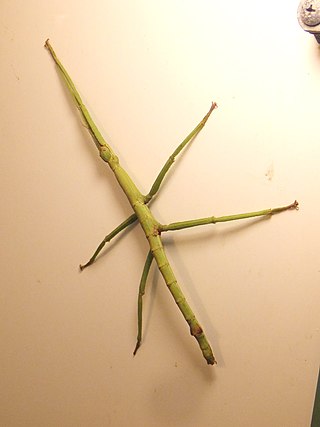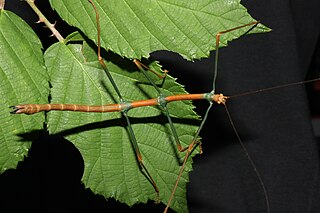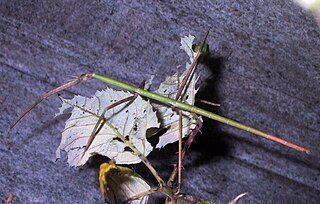
The Euphasmatodea, also known by its junior synonym Verophasmatodea is a suborder of the Phasmatodea, which contains the vast majority of the extant species of stick and leaf insects, excluding the Timematodea. The oldest record of Euphasmatodea is Araripephasma from the Crato Formation of Brazil, dating to the Aptian stage of the Early Cretaceous.

Phobaeticus is a genus of Asian stick insects comprising over 25 species.

Necrosciinae is a subfamily of the stick insect family Lonchodidae, with its greatest diversity in South-East Asia.

Pharnacia is a tropical Asian genus of stick insects in the family Phasmatidae and subfamily Clitumninae.

Lonchodes is a genus of stick insects in the family Phasmatidae and the type genus of the family Lonchodidae and tribe Lonchodini. Species have a known distribution that includes tropical Asia and the Pacific.

Ramulus is an Asian genus of stick insects in the family Phasmatidae and tribe Clitumnini.
Prisomera ignava is a species of phasmid or stick insect of the genus Prisomera. It is found in Sri Lanka.
Prisomera spinosissimum is a species of phasmid or stick insect of the genus Prisomera. It is found in India, Sri Lanka and Malaysia.

Sipyloidea is a genus of stick insects of the family Lonchodidae. Species have been recorded from India, China, Indochina, through to Australasia. The genus was described by Brunner von Wattenwyl in 1893.

Pachymorphinae is a subfamily of stick insects in the family Phasmatidae. Genera are primarily found in Africa, Asia and Australia.

Clonaria is an Asian genus of stick insects belonging to the tribe Gratidiini.

The Clitumninae are a sub-family of stick insects in the family Phasmatidae found in Asia. The type genus Clitumnus is now considered a synonym of Ramulus.

The Lonchodinae are a subfamily of stick insects in the family Lonchodidae found in: Australasia, Asia, Africa, Southern America and the Pacific.

The Gratidiini are a tribe of stick insects based on the type genus Clonaria and first used by Cliquennois in 2005. Genera are known to be distributed in: Africa, Europe, temperate and tropical Asia and various Pacific Islands.

The Platycraninae are an anareolate subfamily of stick insects in the family Phasmatidae. Their known distribution includes southern, southeast Asia and Australasia.

Cuniculina is a genus of phasmids belonging to the family Phasmatidae.
Acacus is a genus of phasmids belonging to the tribe Necrosciini.
Pachymorpha is a genus of phasmids belonging to the family Diapheromeridae.

The Cladomorphinae are a subfamily of stick insects in the family Phasmatidae. This taxon is particularly well represented in the Neotropical region, but records also exist for Madagascar, Java and the Maluku Islands.
Metentoria is a genus of stick insects in the tribe Clitumnini, erected by Carl Brunner von Wattenwyl in 1907. Species have been recorded from: India and Vietnam.













